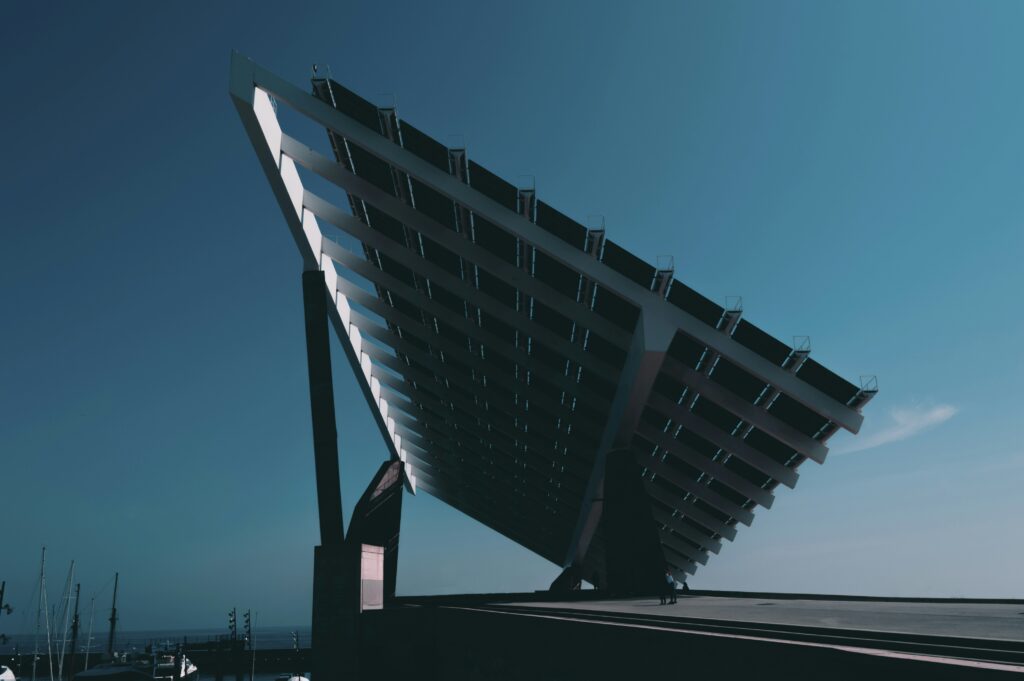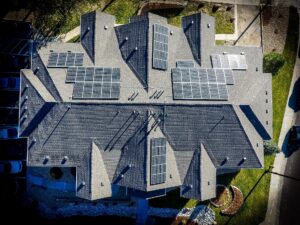Community solar is an innovative solution that allows individuals and businesses to receive the benefits of solar energy, even if they can’t install solar panels on their own property. It works by pooling the resources and investments of multiple participants, who then share the electricity generated by a large solar array. This article explores the concept of community solar, highlighting its advantages, how it works, and its potential to make renewable energy accessible to a wider audience.

Definition of Community Solar
Community solar explained
Community solar is a collaborative approach to solar energy, which allows multiple people or entities to benefit from a shared solar power project. It provides an opportunity for individuals who cannot install solar panels on their own property to still access and use clean, renewable energy. Community solar initiatives bring together a group of participants who collectively contribute to the funding, installation, and operation of a solar system. The electricity generated by the system is then distributed to each participant, who receives credits on their utility bills for the energy produced by their share of the solar panels.
Shared renewable energy
Community solar is a form of shared renewable energy, meaning that it enables multiple participants to collectively benefit from the production of clean energy. It eliminates the need for each individual to have their own solar panels and allows for a more efficient use of resources. By pooling together resources and sharing in the benefits, community solar enables a larger number of people to access the advantages of solar power, while reducing their reliance on fossil fuels.
Benefits of community solar
Community solar offers numerous benefits to participants and the wider community. One of the primary advantages is the accessibility it provides to solar energy. Individuals who are unable to install solar panels on their own property due to various constraints, such as renting or having unsuitable rooftops, can still benefit from solar power through community solar projects. It also offers cost savings, as participants typically receive credits on their utility bills for the energy produced by their share of the solar panels. Additionally, community solar helps reduce carbon emissions and contributes to a cleaner environment by displacing conventional energy sources with renewable energy.
How Does Community Solar Work?
Generating electricity from solar power
Community solar projects generate electricity using solar power, typically through the installation of solar panels on a suitable piece of land or a larger rooftop. These solar panels consist of photovoltaic (PV) cells, which convert sunlight into direct current (DC) electricity. A solar inverter then converts the DC electricity into alternating current (AC), which can be used to power homes and businesses.
Distributing the energy to participants
Once the solar panels generate electricity, it is distributed to the participants of the community solar project. This is typically done through the existing utility infrastructure, where the electricity flows into the grid and is then delivered to the participants’ homes or businesses. While the participants do not have the solar panels physically located on their premises, they still receive the benefits of the clean energy produced.
Virtual net metering and bill credits
To ensure that participants receive the benefits of the electricity generated by their share of the solar panels, virtual net metering (VNM) is often used. VNM allows for the allocation of credits based on the proportionate amount of energy generated by each participant’s share of the solar system. These credits are then applied to the participants’ utility bills, effectively lowering their electricity costs. Participants can also save money through bill credits by receiving compensation for excess energy generated by their share of the solar panels, which can further offset their electricity expenses.

Advantages of Community Solar
Accessibility to solar energy
One of the key advantages of community solar is the improved accessibility to solar energy it provides. Many individuals and businesses may be interested in utilizing solar power but are unable to install their own solar panels due to various reasons such as renting or not having suitable rooftops. Community solar eliminates these barriers by allowing participants to take part in a shared solar project and benefit from the clean energy it produces. This ensures that renewable energy is accessible to a wider range of people, regardless of their individual circumstances.
Cost savings for participants
Participating in a community solar project also offers significant cost savings for participants. By receiving credits on their utility bills for the energy produced by their share of the solar panels, participants can reduce their monthly electricity costs. These savings can be particularly beneficial for low-income households that may struggle to afford the upfront costs of installing their own solar panels. Community solar allows for the sharing of expenses and the optimization of resources, resulting in cost reductions that benefit all participants.
Reduced carbon footprint
Community solar plays a crucial role in reducing carbon emissions and mitigating climate change. By generating electricity from renewable energy sources instead of burning fossil fuels, community solar projects help to reduce greenhouse gas emissions. The collective impact of multiple participants using clean energy from community solar systems contributes to a significant reduction in carbon footprints. By transitioning to renewable energy sources, communities can make a positive environmental impact and work towards a sustainable future.
Who Can Participate in Community Solar?
Residential consumers
Residential consumers are a key demographic that can participate in community solar. Homeowners who are unable to install solar panels on their own properties due to shading, structural limitations, or other factors can still take advantage of community solar to access clean energy. Even renters can participate, as they are not limited by ownership restrictions. Community solar programs provide an opportunity for residential consumers to support renewable energy and reduce their reliance on traditional electricity sources.
Small businesses and nonprofits
Small businesses and nonprofit organizations can also benefit from participating in community solar projects. Many small businesses may face obstacles when considering the installation of their own solar systems, such as limited rooftop space or budget constraints. Community solar allows these entities to still access clean energy and reduce their operating costs. Nonprofit organizations, in particular, can benefit from the cost savings provided by community solar, allowing them to allocate more funds towards their core mission and services.
Renters and people without suitable rooftops
Renters, as well as individuals without suitable rooftops, are often excluded from installing solar panels on their own property. Community solar provides an inclusive solution, allowing these individuals to reap the benefits of solar energy without the need for physical installation on their premises. Renters, in particular, can take advantage of community solar as they are not bound by ownership restrictions. This enables a wider audience to participate in the clean energy revolution, reducing barriers and making solar power more accessible to all.

Community Solar Programs and Policies
State and local programs
Community solar programs and policies vary from state to state and even within local jurisdictions. Many states have established programs that support and incentivize community solar initiatives. These programs may set specific targets for renewable energy generation or offer financial incentives, such as grants or tax credits, to encourage the development of community solar projects. Local jurisdictions can also play a role by implementing policies that encourage community solar participation, such as streamlining permitting processes or offering land-use incentives.
Regulatory frameworks
Regulatory frameworks govern the operation of community solar programs and ensure fairness and transparency. These frameworks govern issues such as participant eligibility, pricing mechanisms, and compensation for excess energy generation. They may also define the roles and responsibilities of different stakeholders, such as the project developer, the participants, and the utility company. Establishing clear and consistent regulatory frameworks is crucial to the successful implementation and operation of community solar projects.
Incentives and subsidies
Incentives and subsidies are often provided to support the development of community solar projects. These incentives can take various forms, including financial incentives, tax credits, or grants. Some states and utilities offer specific incentive programs aimed at encouraging community solar participation. These incentives and subsidies help offset some of the costs associated with community solar projects, making them more financially viable and attractive to developers and participants alike.
Challenges and Limitations of Community Solar
Lack of available projects
One of the challenges facing community solar is the lack of available projects. While the demand for community solar is growing, the number of projects being developed is not always sufficient to meet this demand. This can be due to various factors, such as limited funding, difficulties in finding suitable locations, or regulatory barriers. Increasing the availability of community solar projects requires continued investment, streamlined permitting processes, and supportive policies to incentivize developers to undertake new projects.
Financial considerations
Financing community solar projects can pose a significant challenge. The upfront costs of installing solar panels and associated infrastructure can be substantial, and securing financing for these projects is not always straightforward. Additionally, the economic viability of a community solar project relies on attracting a sufficient number of participants and ensuring an adequate return on investment. Balancing the financial aspects of community solar projects requires careful planning, collaboration with financial institutions, and innovative financing models that lower barriers to participation.
Policy and regulatory barriers
Community solar projects are subject to various policies and regulations that can present barriers to their development and implementation. These barriers can include complex and lengthy permitting processes, interconnection challenges, or grid integration issues. The lack of uniformity in regulatory frameworks across different jurisdictions can also hinder the scalability and growth of community solar. Streamlining regulatory processes, harmonizing industry standards, and establishing clear guidelines can help overcome these barriers and encourage wider adoption of community solar.

Success Stories and Impact of Community Solar
Case studies of successful community solar projects
Many community solar projects have achieved success and demonstrated the potential impact of this approach to solar energy. For example, the Arcadia Power Community Solar Project in Maryland has provided renewable energy to over 25,000 participants, while the Clean Energy Collective’s community solar program in Colorado has enabled residents to access clean energy without the need for individual installations. These success stories showcase the feasibility and scalability of community solar projects and inspire others to adopt similar initiatives within their communities.
Environmental and social benefits
Community solar projects offer numerous environmental and social benefits. By generating clean energy, these projects contribute to the reduction of greenhouse gas emissions, helping to combat climate change and improve air quality. Community solar also empowers local communities, allowing them to take ownership of their energy supply, reduce reliance on external sources, and promote resilience. It fosters a sense of community engagement and participation, reinforcing the importance of renewable energy and sustainable living.
Empowering local communities
Community solar has the power to empower local communities by providing them with a stake in the clean energy transition. By participating in community solar projects, individuals and communities become active contributors to the renewable energy sector, shifting the power dynamics from centralized utility companies to local stakeholders. Community solar encourages collaboration, fosters educational opportunities, and strengthens community bonds, ultimately leading to greater resilience and self-sufficiency.
Future Outlook for Community Solar
Growing popularity and adoption
Community solar is gaining increasing popularity and adoption across the United States. As awareness of climate change and the need for sustainable practices grows, more individuals and communities are seeking ways to reduce their carbon footprint and support renewable energy. Community solar offers an accessible and inclusive solution, allowing a wider audience to participate in the clean energy revolution. As the benefits of community solar become more well-known and programs continue to expand, it is expected that the popularity and adoption of community solar will continue to grow.
Technology advancements
Advancements in solar technology are also expected to drive the future of community solar. Improvements in the efficiency and affordability of solar panels, as well as the development of energy storage solutions, will enhance the capabilities and benefits of community solar projects. As technology advances, it is anticipated that community solar will become even more attractive and financially viable, further accelerating its growth and adoption.
Policy changes and expansion
Policy changes and expansions at the federal, state, and local levels will also influence the future of community solar. Continued support and incentives from governments can encourage the development of new community solar projects and increase participation. The establishment of clear regulatory frameworks and streamlined permitting processes will further facilitate the growth of community solar. As policymakers recognize the environmental, economic, and social benefits of community solar, it is expected that more favorable policies will be implemented to support and expand these initiatives.
Conclusion
Community solar is an innovative and inclusive approach to sustainable energy that allows individuals, businesses, and communities to benefit from solar power without the need for individual installations. By facilitating shared renewable energy projects, community solar provides accessibility to clean energy, cost savings, and a reduced carbon footprint. It opens up opportunities for residential consumers, small businesses, nonprofits, renters, and those without suitable rooftops to participate in the clean energy transition. While community solar faces challenges such as limited available projects, financial considerations, and policy barriers, its success stories, environmental impact, and ability to empower local communities highlight its potential. With growing popularity, advancements in technology, and supportive policies, community solar has a promising future that will contribute to a sustainable and resilient energy system.




